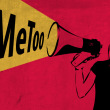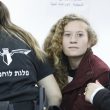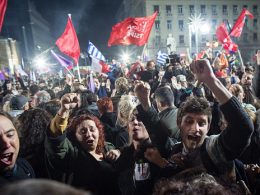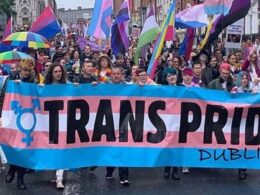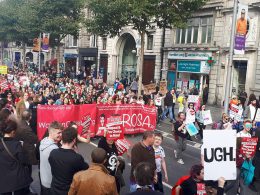Sudden largescale nationwide protests have shaken Iran. Sections of the masses have shown utter defiance of the regime. Youth, facing unemployment estimated to be between 25% and 40%, have particularly been to the fore. The protests, initially against the rise in prices and corruption, almost immediately developed into fighting and clashes with security forces with a mounting death toll. In some cities, people attacked police stations, pro-regime paramilitary headquarters and religious seminaries. This rapid development seemed unbelievable even for the most optimistic political analysts and activists.
The immediate spark was opposition to December’s announcement of more neo-liberal policies by the “moderate” President, Hassan Rouhani, as well as a sharp rise in staple goods’ prices alongside the publication of details of the lavish financing of religious bodies. With continuing mass unemployment and an average 15% drop in living standards over recent years, the protests spread rapidly across the country.
The economic crisis has deepened over the last few years. This is seen in the huge debts of the government to banks, the depletion of resources of pension funds, the bankruptcy of financial institutions and an unbelievable amount of corruption and embezzlement, which directly damaged the working class’s living conditions. This, along with the growing visibility of a wealthy elite, was another key factor in these protests, which heard calls of “Down with the embezzlers!”
The Rouhani administration boasted about reducing inflation to single-digits and increasing the growth rate to six per cent. However, the first was partially achieved by neo-liberal measures, while the second was just the product of the regime’s ability to export oil after a part of UN-imposed sanctions were lifted.
The regime has also depleted its resources by involving itself in wars in Iraq, Syria and Yemen. Additionally the Lebanese Hezbollah leader openly announced that they receive all the money for their party and for improving infrastructure in South Lebanon from Iran. The regime pays huge funds to the military forces it backs in Iraq too. The regime’s ambitious foreign policy plans have costs which the Iranian working class has to pay. The regime, for a while, sought justification through fearmongering about the emergence of terrorism inside Iranian borders etc. However, with the fall of ISIS, the regime’s bogey man has largely disappeared, at least for now.
Trump’s coming into office aggravated the situation and shattered the Iranian regime’s dreams of attracting foreign investments. Iranian banks have not been able to return to the international banking system.
During the last three or four years, two major movements kept the flame of opposition alight – the workers’ movement and the campaign by depositors in bankrupt financial institutions.
Major strikes and pickets took place in Arak in north-western Iran and oil and gas rich areas in the south, along with continuing protests at the repression of trade union activists like a leader of the Tehran bus workers and others from the Haft-Tapeh Sugar Company in Khuzestan.
The financial institutions, which were mostly founded by people affiliated to the regime, have robbed millions of dollars from depositors, ranging from low-income people who deposited tiny amounts to live on, to rich people who received huge interest payments. The story of these institutions, as well as colossal embezzlements in the Teachers’ Pension Fund, and Social Security Organisation, is not about simple capitalist profiteering, it is like a Middle Age story of plunder. None of the corrupt officials have been punished.
Budget adds fuel to fire
What added fuel to the fire was December’s announcement of Rouhani’s 2018 budget bill that proposed an increase in prices of petrol and gas oil of around 40%. At the same time egg prices suddenly rose in recent weeks. This means that the poor cannot afford even very basic food. The budget also proposed ending the 455,000 rial (US$12.60) monthly payments under the Cash Subsidy Programme to around 34 million people, about 40% of the existing recipients.
Furthermore the budget bill’s publication of the huge allocation of funds to parasitic religious institutions enraged people. While this budget plan spoke of increasing state expenditure by 6%, with inflation officially running at nearly 10% it really continued the neoliberal cuts policies which Rouhani introduced after taking office in 2013 (the figures published by Iran’s statistical centres are highly contradictory, and the real inflation and unemployment rates are expected to be much higher).
The growth of social media has completely overshadowed state-run news outlets, allowing people to share more freely their anger and dissatisfaction. There were around one million smartphones in Iran at the time of the last mass protests in 2009, now there are reported to be 48 million.
The people, with no independent, class struggle trade unions allowed in Iran, used any gap and space possible to raise their demands. The deepened crisis and anger has widened the divisions and infighting inside the regime and ex-president, Ahmadinejad, began to bitterly attack the judiciary and the executive. Khamenei warned Ahmadinejad in an attempt to silence him but the so-called Supreme Leader has lost his authority even inside the regime.
Under these circumstances, the December 28 protests in Mashhad were a spark. First, the focus was on rising prices and corruption but quickly became more broadly political. The crowd shouted “death to the dictator” and called for freedom for political prisoners. Even if there was fear that the so-called regime “hardliners” incited the protests to use it as a lever of pressure on Rouhani it is clear that they lost control of the protests almost as soon as they began!
The following day, similar demonstrations happened in Tehran, Rasht, Kermanshah, and Ahvaz with slogans that targeted the top leaders of the regime.
The character of this movement is that it is mostly spontaneous without a unified leadership, and is largely based on the masses’ initiative on the ground. Remote towns and cities are not waiting for large cities. They have engaged in the movement completely independently.
The regime was briefly paralysed and hesitated to launch a very violent counter-offensive, though it has arrested hundreds and killed at least 21 so far. Wherever it has tried to use what it calls its “iron hand” the people punished it severely. In Malayer and Shahinshahr, people reportedly occupied police stations and the highest local cleric’s office. This is not only happening in Fars (Persian) areas, but Kurds and Baluchis have also joined the protests. Women have played a remarkable role in the movement.
Nobody could imagine this situation even a week ago. While it is not clear how this movement from below will immediately develop, it is very clear that what we are seeing is amazing bravery, tremendous anger and huge desire for freedom and social justice.
Political characteristics of movement
This movement is totally based on the masses’ initiative. Many have completely broken with the reformist leaders of the 2009 Green movement, who just used the people in the elections and in dividing up power with the other main faction in the ruling elite. The so-called reformist faction even openly condemned the current protests and called for their suppression. This movement showed the widespread disappointment with President Rouhani, who was overwhelmingly re-elected in last May with over 57% of the vote,
The bulk of the movement has shifted from a big layer of the petty-bourgeoisie and middle layers, who predominately made up the 2009 Green protests, to the working class, the unemployed and lower and middle petty-bourgeois layers. The accumulated anger has extremely radicalised the movement. The masses no longer believe in Gandhi-type “non-violent” and “silent” demonstrations. They openly call for overthrowing the regime.
Women, as before, have played a remarkable role in the movement and sometimes they engage more daringly than men. This is because of the double oppression they have suffered under the harsh Islamic rules.
Such is the scale of the protests the population of small towns in remote areas no longer wait for large cities.
Prospects
At the time of writing, the Iranian regime’s suffocating censorship of the Internet limits the amount of accurate, up to date, information of what is happening around the country.
We are not sure how long these spontaneous protests will continue but what is certain is that it opened a new chapter in Iranian post-1979 revolutionary history. We can divide this history to three stages; from the February 1979 revolution to the June 1981 crackdown, from that crackdown to December 2017. In the first stage, the regime could crush the 1979 revolution and consolidate its position. During the second period, the Themidor (reaction), survived despite its crises, such as the 2009 Green movement, as people still hoped for reforms by the regime, especially the so-called reformist factions. This new, third stage marks the start of a full break from the regime and its factions by significant layers. Rule by the clergy is increasing seen as being responsible for what is happening.
However, despite its high level of militancy, this movement suffers from serious weaknesses. It is still in its very early stages and, with the absence of a revolutionary party able to propose a clear strategy, it faces the risk of losing momentum despite its rapid rise. Inevitably, this weakness, combined with the fact that this movement is in its very early stage, produces mixed and contradictory trends in the consciousness of the participants. Thus sometimes even slogans in support of the pre-1979 revolution monarchy can be heard, though this was not the dominant mood.
The initial sphere of action of this movement was on the streets, and it has not yet fused with workplace protests. Only being in the open spaces and streets does not ensure the movement’s survival, it needs to shape itself around factories, workplaces, communities and educational institutions.
If the working class in the main industries – oil, gas, petrochemical and automobile – engages in even a 24-hour strike it would put its seal on the movement and will give it a huge drive forward. However, we have not observed signals for such a step forward.
What is to be done?
Iran’s Left must try to learn from the lessons of the 1979 revolution, the 2009 protests and the experience of revolutionary struggles in the world, especially in the recent “Arab Spring”. This also requires a greater sense of internationalism and cooperation with the forces of the international socialist movement.
The Left must react to these new opportunities with proposals for activity, organisational forms and practical methods to strengthen and improve this movement. The Left must be equipped with new means of communications which, despite the regime’s attempts to restrict their use, can nowadays play a crucial role in reaching the masses and use these means, including social media, to disseminate information and proposals to help in organising the next steps.
While the current protests may wind down, they have fundamentally changed the situation in Iran. This experience can lay the basis for the building of a workers’ movement that can challenge both the regime and capitalism. First steps must be the bringing together of activists in groups and committees to co-ordinate activities and work out demands and programme. The left must start a dialogue to form a united front, as a step towards founding a democratically-run mass working class party that can bring together workers, the poor and youth in fighting for an alternative.
Marxists would argue for a programme that links demands for democratic rights, against repression, to defend and improve living standards with the need for a government of genuine representatives of workers and the poor that can begin the socialist transformation of Iran by nationalising, under democratic control, the commanding heights of the economy. This would have enormous appeal to working people across the Middle East and beyond.
The Left must warn of imperialist-backed intervention to subvert and divert the movement. Trump’s hypocrisy must be exposed, while professing “support” for the Iranian people he embraces the Saudi dictatorship. At the same time any illusions among layers of people that pro-Western bourgeois alternatives may bring a better life for the people need to be combated with a socialist programme that explains what could be achieved if capitalism is overthrown.
Only a society ruled by representatives of the workers and toilers can resolve the chronic crises in Iran, win democratic rights, and put an end to poverty and oppression based on gender, religion and ethnicity. A workers’ revolution in Iran will stimulate progressive, democratic and socialist forces in the Middle East and cut across reactionary Islamist ideas and forces.






